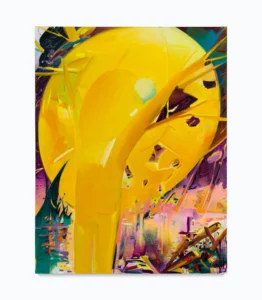This series of interviews with a group of former Slade School of Fine Art students, whose works have been on display at this year’s Frieze London, is aimed at demonstrating the diversity of life and experience that is to be found within the world of professional artmaking. Coming to Slade from a wide range of backgrounds, and across a wide range of years, these artists have each approached art and artmaking from vastly different perspectives, deeply embedding their own personal experiences of place, memory, and identity into their work. Joining together through their shared experience of art school in London, their interviews attest to the diversity of experience that is possible when building a career in London and the wider art world and will hopefully be sources of solace and encouragement for those looking to a future in artmaking.

Jin Han Lee is a Korean artist born in Soeul who graduated with a PHD from the Slade in 2021. Her oil paintings challenge the limits of meaning and language, communicating experience through a deeply sensory medium.
I’d be interested to know what your relationship was like to art and artmaking before you had the experience of a formal art degree?
I can’t recall a time before I started my art education, but I think I always lived with a heightened awareness of language. My thoughts build on an everyday experience of misunderstanding/being misunderstood and the consequent gaps opened up by what is untranslatable. I kept on thinking what this and that meant, really, and art has always been an answer to that for me.
Your work deals a lot with ideas of language and communication, how best to represent lived experience etc., I’d be curious to know what initially influenced you to pursue the medium of painting instead of say writing or formal academia?
Painting, to me, is a theatrical interface in which I, as a painted protagonist, narrate my experiences of miscommunication and being lost in translation—literally eluding the authority of language. I bring together the graphic and the pictorial, deploying motifs chosen for their symbolic and semiotic value within the expressive potential of painting. My painting explores the capacity of the medium to express what is untranslatable in language and I use oils—the epitome of a traditional material—in an unorthodox manner, varying scale, gesture, colour, surface texture etc. to create a spatial fragmentation. Composed from images significant within my own lived and imagined experiences, previously or elsewhere narrated in writing, these paintings create sensations or schematizations around motifs whose meaning I cannot pin down in words. My painting is, for me, a language that I visualize.
Moving through to your time at Slade School of Fine Art, what was the experience like of developing your practice in artmaking whilst simultaneously living in a place that differed significantly both linguistically and culturally from your early life?
The paintings I have made since I started being part of a UK art education all have a story behind them, or one that precedes them, so that I always wrote and painted the works following particular encounters or experiences. These stories are stories of arrival. They involve experiencing something that I cannot express in language—not in English, and not even in my first language, Korean. Any attempt seems somehow excessive, or ambiguous, and at the limit of what I can say. Its meaning cannot be pinned down and fixed with words. I used such experiences, encounters and difficulties as opportunities to imagine a number of possible meanings. These are what I expressed in the paintings in early days when I felt the clash between cultures and languages. They were created quite quickly, directly, literally, and irreverently and I use emotional qualities, imbued by Korean heritage. This is, to me, a tool to build a dynamic and inclusive sense of commonality that embraces the difficult and different cultural experiences that one can be exposed to in the UK.
While at Slade you produced some interesting work on cultural understandings of time and identity. How has both that research and the experience of studying art through a significantly theoretical lense at the Slade shaped the work you’re producing today?
Over the seven years of PhD study, through my work engaging with the wonderful academics, time and time again I encountered my own past in terms of what I struggled with as a young, troubled art student with an Asian heritage and I have come to acknowledge how my linguistic and artistic journey of shaping my own personal language has evolved over time. Slade, is to me, a symbolic place where I confronted my hardships and was able to pave an academic and artistic path forward. My language and what I wanted to develop was always heard and understood by them.
Finally, looking back on the different experiences and ideas that have shaped your life, what would be your advice for those young artists who are potentially looking for a career in artmaking?
I have always had my paintings near me; we have always shared the same space. Looking at my own works closely, I asked these questions: what do my paintings do? What do my paintings want? I must confess I could never answer these questions and I still can’t. Perhaps that then is good advice for young artists as well as for myself: keep asking what does my art do/want?





